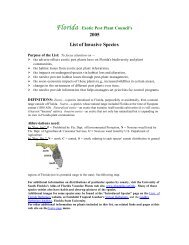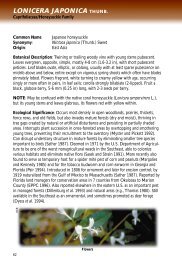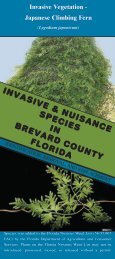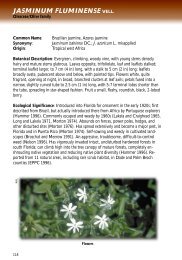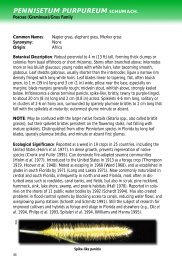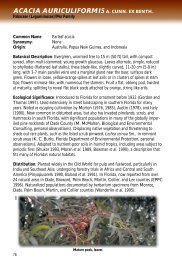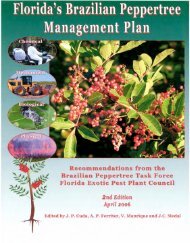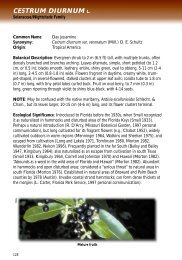DICOTS - Florida Exotic Pest Plant Council
DICOTS - Florida Exotic Pest Plant Council
DICOTS - Florida Exotic Pest Plant Council
You also want an ePaper? Increase the reach of your titles
YUMPU automatically turns print PDFs into web optimized ePapers that Google loves.
Sapium sebiferum (L.) Roxb.<br />
Euphorbiaceae/Spurge Family<br />
Common Names: Chinese tallow tree, popcorn tree<br />
Synonymy: Croton sebiferus L., Stillingia sebifera Michx., Triadica sebifera (L.)<br />
Small<br />
Origin: Eastern Asia<br />
Botanical Description: Deciduous tree to 16 m (52 ft), commonly to 10 m (33 ft). Sap<br />
milky. Leaves simple, alternate; blades entire, broadly ovate, 3-6 cm (1-2.5 in) wide, with<br />
broadly rounded bases and abruptly acuminate (tapering to a slender point) tips; petioles<br />
slender, 2-5 cm (1-2 in) long. Flowers small, yellow, borne on spikes to 20 cm (8 in)<br />
long, with 2-3 sepals (petals absent), 2-3 stamens or 3 styles (plants monoecious). Fruit a<br />
3-lobed capsule, 1 cm (0.5 in) wide, turning brown and splitting open at maturity to<br />
reveal 3 dull white seeds, which remain attached for a time.<br />
Ecological Significance: Considered a common agricultural weed in Taiwan, requiring<br />
constant effort and expense to hold at bay (Holm et al. 1979). Introduced repeatedly to<br />
the United States as an ornamental and potential oil crop species (Jones and McLeod<br />
1989). Considered an invasive pest plant in the Carolinas since the 1970s. Has expanded<br />
its range on the United States Gulf Coast in low-lying areas, becoming dominant and<br />
spreading along roadside ditches and into areas where the soil stays wet (Cameron and<br />
LaPoint 1978). Also thrives in upland, well-drained areas near human habitation and in<br />
undisturbed areas such as closed canopy forests, in bottomland hardwood forests, shores<br />
of waterbodies, and sometimes on floating islands (Godfrey 1988). Survives in both<br />
poorly drained freshwater and saline soils as well (Scheld and Cowles 1981). Tends to<br />
take over large areas (Bonner 1974).<br />
KAL<br />
74<br />
Flowers



